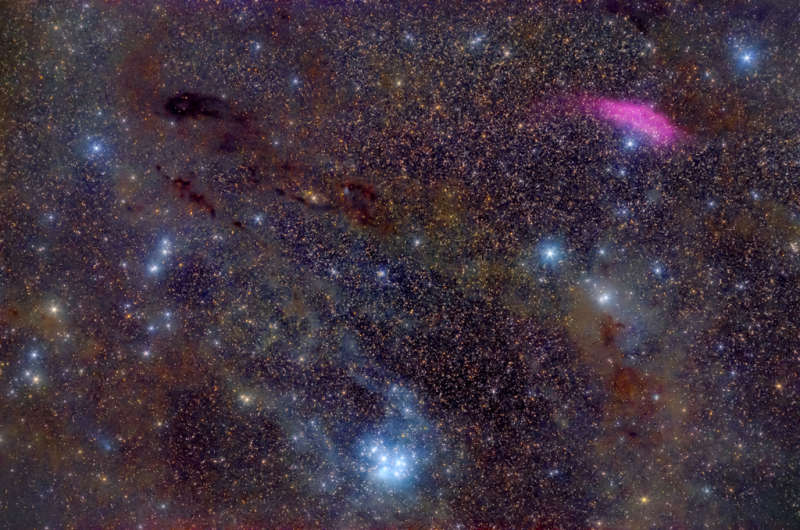Credit & Copyright: JoAnn McDonald
Explanation:
The comet PanSTARRS, also known as
the blue comet (C/2016 R2),
really is near the lower left edge of this stunning, wide field view
recorded on January 13.
Spanning nearly 20 degrees on the sky,
the
cosmic landscape is explored by well-exposed and processed frames
from a sensitive digital camera.
It consists of colorful clouds and dusty dark nebulae otherwise
too faint for your eye to see, though.
At top right, the
California Nebula (aka NGC 1499) does have a
familiar shape.
Its coastline is over 60 light-years long and lies
some 1,500 light-years away.
The nebula's pronounced reddish glow is from hydrogen atoms ionized
by luminous blue star Xi Persei just below it.
Near bottom center, the famous
Pleiades star cluster is some 400
light-years distant and around 15 light-years
across.
Its spectacular blue color is due to the reflection of starlight
by interstellar dust.
In between are hot stars of the Perseus OB2
association and dusty,
dark nebulae along the edge of the nearby,
massive Taurus and Perseus molecular clouds.
Emission from unusually abundant ionized carbon monoxide (CO+)
molecules fluorescing in sunlight
is largely responsible for the telltale blue tint of the
remarkable
comet's tail.
The comet was about 17 light minutes
from Earth.
1999 2000 2001 2002 2003 2004 2005 2006 2007 2008 2009 2010 2011 2012 2013 2014 2015 2016 2017 2018 2019 2020 2021 2022 2023 2024 2025 |
Январь Февраль Март Апрель Май Июнь Июль Август Сентябрь Октябрь Ноябрь Декабрь |
NASA Web Site Statements, Warnings, and Disclaimers
NASA Official: Jay Norris. Specific rights apply.
A service of: LHEA at NASA / GSFC
& Michigan Tech. U.
|
Публикации с ключевыми словами:
comet - pleiades - emission nebula - кометы - Плеяды - эмиссионная туманность
Публикации со словами: comet - pleiades - emission nebula - кометы - Плеяды - эмиссионная туманность | |
См. также:
Все публикации на ту же тему >> | |
